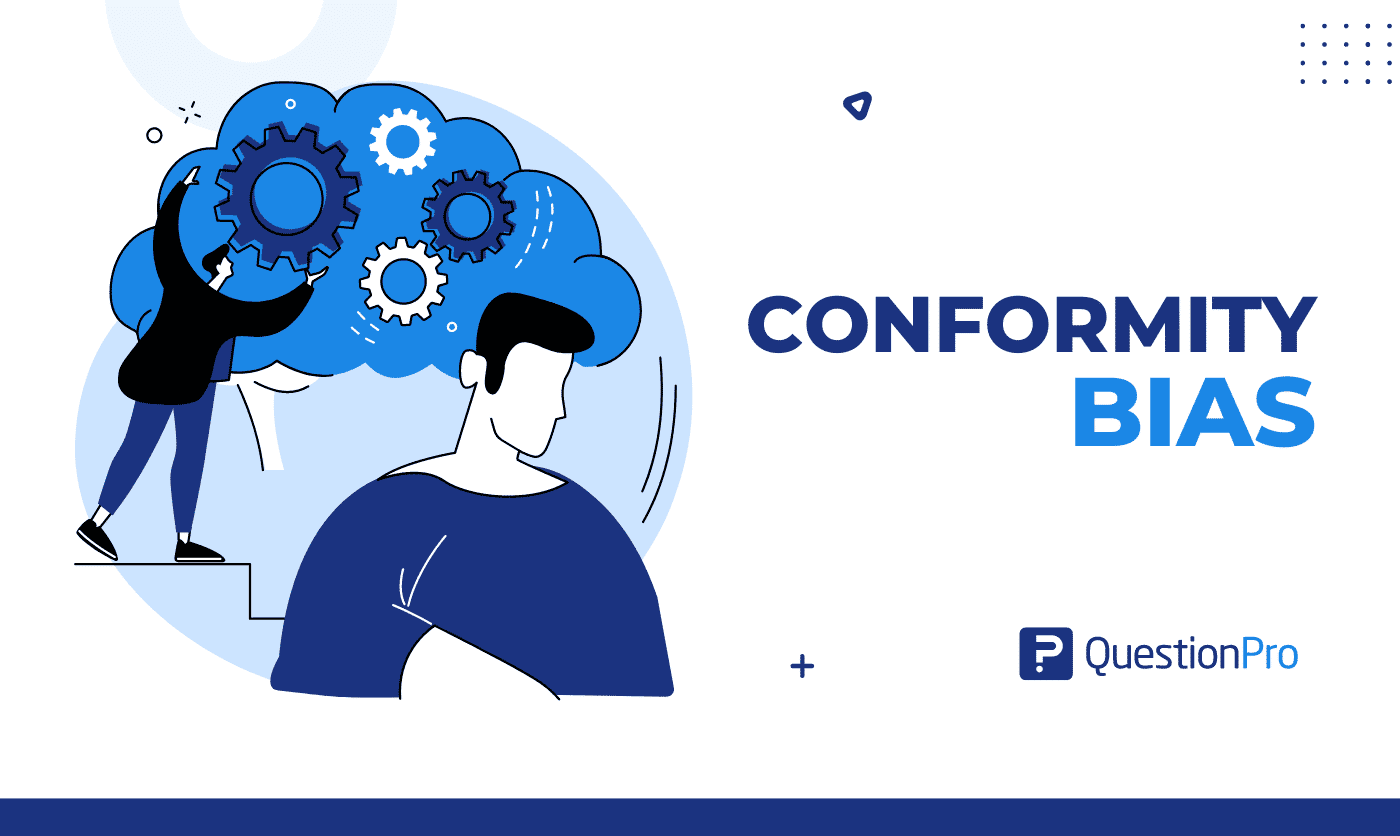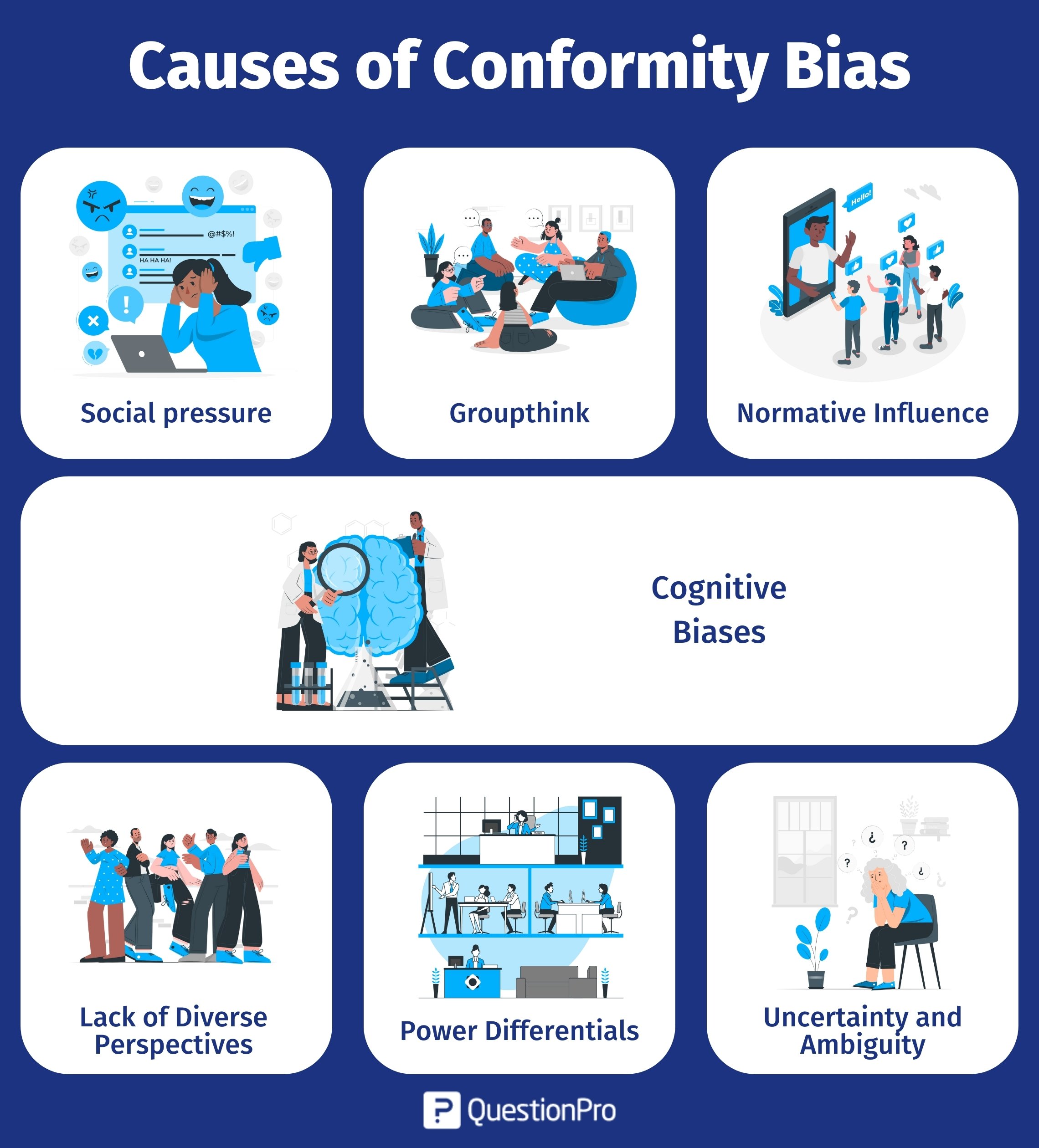
We’re going to look at conformity bias, also known as the bandwagon effect, which is one of more than a hundred different types of bias in our environment. It’s human nature to strive to fit in with groups where one would feel like one “belongs,” as we all want to be accepted at work. It’s in everyone’s nature to conform, though to varying degrees.
But since it’s a symptom of unconscious prejudice, it can impair our capacity to reach unbiased judgments. Because of this, it could limit our vision and our company’s success if leaders don’t notice it or don’t care about it.
LEARN ABOUT: Behavioral Research
So in this blog, we will discuss conformity bias, its types, tips, and examples.
What is conformity bias?
Conformity bias occurs when we change our behavior to fit in with the group because of a deep-seated yearning to belong.
To follow the party line, people emulate other people’s behavior rather than using their own moral and ethical own independent judgment. Even while it may not be our objective, this kind of behavioral ethics research addresses can significantly impact our capacity for objectivity.
A classic example of this would be if you were at a restaurant with two pals and wanted to have dessert, but they all objected. As a result, you decline as well—not because you’ve made up your mind you don’t genuinely want that delectable slice of chocolate cake, but rather because everyone else did.
Famously, psychologist Soloman Asch looked into how peer pressure could lead someone to conform. A startling 75% of subjects conformed at least once during the twelve crucial trials. Participants admitted they weren’t confident of their accepted response but stuck with it out of concern for how their peers might react.
Types of conformity bias
Learn about each of the four different types of conformity bias.
1. Compliance
Compliance is when a person gives in to pressure from another person or group to get something from them. The person wouldn’t agree with the ideas in private, but the threat of punishment or the chance to get something may make him agree.
2. Internalization
Internalization occurs when someone accepts influence because it is rewarding in their private and public lives.
Example: A severe degree of conformity in which the group absorbs the individual’s opinions. Doesn’t that remind you of all those political workers, hmm?
3. Identification
Individual acceptance of influence because he desires a satisfactory self-defining relationship with another group or person. Isn’t it true that a police officer is drawn to another law enforcement officer, and so on?
4. Ingratiation conformity
This occurs when someone wants to fit in with the group’s beliefs to impress them or win their favor. In this case, the person is not afraid of being left out like they are with normative influence. Instead, they want to get something good from the group.
Causes of conformity bias
Organizations may reduce conformity bias with a range of tools and strategies. Conformity bias, or the tendency to conform to the opinions or behaviors of others, can arise from various causes. Understanding these causes can help organizations address and mitigate the impact of conformity bias. Here are some common causes:

Social pressure
Humans have an innate desire to belong and be accepted by their social groups. The fear of social rejection or ostracism can lead individuals to conform to the majority opinion, even if they disagree. This pressure to conform can be particularly strong in hierarchical or tightly-knit organizational cultures.
Groupthink
Groupthink occurs when the desire for consensus overrides critical thinking and independent decision-making. In cohesive groups, individuals may prioritize harmony and unity over expressing dissenting opinions. This can lead to a narrowing of perspectives and a suppression of innovative or alternative ideas.
Normative influence
Norms are unwritten rules or expectations that guide behavior within a group. Individuals may conform to these norms to avoid disapproval or punishment. Normative influence can create conformity bias by discouraging dissenting opinions or stifling creative thinking that deviates from the established norms.
Cognitive biases
Several cognitive biases can contribute to conformity bias. For example, the bandwagon effect occurs when individuals adopt the opinions or behaviors of others simply because they are popular or widely accepted. The availability heuristic, where people rely on immediate examples that come to mind, can also lead to conformity as individuals conform to what seems familiar or prevalent.
Lack of diverse perspectives
When teams or organizations lack diversity in terms of backgrounds, experiences, or perspectives, conformity bias can be more pronounced. Homogeneous groups may have limited exposure to differing viewpoints, leading to a reinforcement of existing beliefs and a resistance to alternative ideas.
Power differentials
Power dynamics within organizations can influence conformity bias. Subordinates may conform to the opinions of superiors due to a fear of repercussions or a desire to gain favor. Power imbalances can suppress dissenting voices and discourage individuals from expressing their independent thoughts.
Uncertainty and ambiguity
In situations where there is uncertainty or ambiguity, individuals may look to others for guidance and rely on their opinions to make ethical and unethical decisions. This can result in addressing conformity bias as people conform to the beliefs of those they perceive as more knowledgeable or confident.
It’s important to recognize that conformity bias is a natural human tendency that can emerge in various contexts. By understanding the causes, organizations can implement strategies to mitigate its negative effects and promote a culture of independent thinking, diversity of thought, and open dialogue.
Tips for conformity bias
We’ll go through three simple tips to help you control conformity bias in workplace meetings.
1. After everyone else has spoken, the boss should last express their opinion.
Now, this suggestion may appear to be somewhat ineffective! After all, shouldn’t the meeting’s leader set an example by engaging in frank conversation at the outset? Such a plan makes perfect sense in an ideal world.
Everyone tends to agree with the boss not just because they are the boss but also because everyone else agrees when they speak first because of their position of power, which unintentionally sends the idea that they must be right. (This illustrates the bandwagon effect’s strong cyclicality.) But since we live in a less-than-ideal environment, we must do everything we can to combat prejudice.
Because of this, the boss should let every other meeting participant speak first to show that opposing viewpoints are acceptable and required for a fruitful discussion.
2. Create a simultaneous voting system.
Last but not least, it is impossible to sweep the topic of voting at meetings under the rug! Address conformity bias from decision-making processes is crucial because it frequently results in a false unanimity of viewpoints.
Fortunately, there is a straightforward fix: create a simultaneous voting system! The “thumbs up, thumbs down” technique is what I advise. When voting, don’t allow one person to speak at a time because this technique is more likely to cause people to vote because they don’t want to disagree rather than because they agree.
Instead, ask everyone present to offer a thumbs up (yes) simultaneously or a thumbs down (no)! This straightforward method ensures that no one is excessively affected by the opinions of others.
3. Designate someone as the “critic.”
Although the term “devil’s advocate” has a bad reputation that most people would prefer to avoid, it may also refer to this viewpoint as such. Appointing a critic enables the debate of many points of view essential for a fruitful meeting, as mentioned in the previous advice.
It should be noted that just because someone criticizes a concept doesn’t mean they reject it or treat it in any other way that is less than favorable. We might envision the critic as someone who queries why—
- Why do we think [x] is a superior tactic compared to [y]?
- Why don’t we think [q] will make a good mate like [p]?
Can conformity bias lead to unethical behavior?
Certainly, conformity bias may be detrimental to an individual’s moral character. Those who performed the experiment voluntarily received potentially lethal electrical shocks. It can indeed lead to unethical behavior.
Conformity bias refers to individuals’ related behavioral ethics concepts or tendencies to adopt a group’s behavioral ethics concepts, attitudes, beliefs, and behaviors, even if they may be contrary to their values or ethical standards.
When people conform to a group, they may suppress their own moral judgment and go along with actions or decisions their behavioral ethics draws that they would otherwise consider unethical.
Here are a few ways in which conformity bias can contribute to unethical behavior:
Group pressure
Conformity bias can cause individuals to yield to social pressure, even if it means engaging in unethical behavior. People may fear being ostracized, rejected, or criticized by the group if they voice their disagreement or stand up for what they believe is right.
Diffusion of responsibility
When individuals conform to a group, they may experience a diffusion of responsibility, where they feel less accountable for their actions. This diffusion can lead to a diminished sense of personal responsibility for unethical behavior because individuals believe others share the responsibility, making it easier to justify or rationalize their actions.
Groupthink
Conformity bias can contribute to groupthink, a phenomenon in which a group’s desire for consensus and harmony overrides critical thinking and ethical judgment. Group members may suppress their doubts or dissenting opinions to maintain group cohesion, resulting in unethical decisions or actions that go unchallenged.
Moral disengagement
Conformity bias can enable individuals to disengage from their moral standards mentally. They may distance themselves from the consequences of unethical behavior by attributing responsibility to the group or the situation rather than to themselves.
It is important to be aware of the potential influence of behavioral ethics bias or conformity bias and actively engage in ethical decision-making processes. Encouraging open dialogue, promoting independent thinking, and fostering an ethical culture can help mitigate the negative impact of conformity bias and prevent unethical behavior.
Conclusion
Conformity bias is sneaky, but it’s not the only bias that can be found in most places of work. You can get rid of research bias when hiring people.
When you get it right, you get better hires and a more diverse group. QuestionPro is here to help you and answer any questions you have. Don’t let biases like the need to fit in with society hinder your hiring decisions.
You can fight against conformity bias with the help of QuestionPro’s many tools and options. Use QuestionPro immediately if you want to do your fair, agree, or disagree research.







